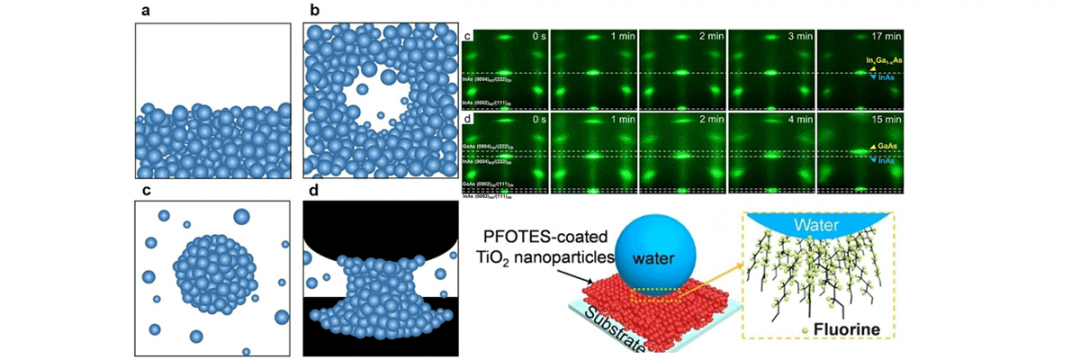Next-Generation Quantum Device Research
Graphene & Nanomaterials Research
Nanophotonics & Optical Display Research
Single-biomolecular Analysis Research
Next-Generation Quantum Device Research

In ultra-small dimensions of condensed matter such as semiconductor and metal, various quantum phenomena are observed due to the wave-like character of charged particles. Examples of such quantum phenomena are superconductivity and magnetic spinning phenomenon. The Next Generation Quantum Device Research Group is committed to developing next-generation quantum devices based on the understanding of the fundamentals of the quantum phenomena observed in condensed matter.
Topics of basic research on quantum phenomena in condensed matter are, to give some examples, new materials, emergent phenomena, interactions between electrons, topological effects, compound semiconductors, high-temperature superconductors, surfaces, interfaces, synthetic metals, transition metals, rare-earth metal oxides, quantum dots and quantum wells, magnetism and spintronics, and low-temperature properties.
Given the difficulties associated with solving important problems in the field of condensed matter physics, cooperative research is often required among experts from different subfields of condensed matter physics and experts from other disciplines. Our Institute has witnessed great synergistic effects of collaborative research among over 20 professors dedicated to different topics of condensed matter physics. They also conduct collaborative research with other research teams at home or abroad.
Topics of basic research on quantum phenomena in condensed matter are, to give some examples, new materials, emergent phenomena, interactions between electrons, topological effects, compound semiconductors, high-temperature superconductors, surfaces, interfaces, synthetic metals, transition metals, rare-earth metal oxides, quantum dots and quantum wells, magnetism and spintronics, and low-temperature properties.
Given the difficulties associated with solving important problems in the field of condensed matter physics, cooperative research is often required among experts from different subfields of condensed matter physics and experts from other disciplines. Our Institute has witnessed great synergistic effects of collaborative research among over 20 professors dedicated to different topics of condensed matter physics. They also conduct collaborative research with other research teams at home or abroad.
Graphene & Nanomaterials Research

Nanophysics and nanophotonics are research fields that explore various physical phenomena occurring in the realm of nanometer (10-9 m) dimensions, produce nanomaterials or nanostructures, observe and determine their physical properties such as mechanical, electrical, and optical properties, and apply the research results.
Nanophysics and nanophotonics are not limited to the realm of physics, but aim to understand newly observed nanoscale phenomena going beyond the scope of conventional explications based on phenomenal principle of matter and structure by integrating other disciplines, such as chemistry, biology, material engineering, and electronics, in pursuit of diverse applications as nanoscale materials and devices based on the knowledge and insight thus gained. Likewise, nanophysics and nanophotonics are basic academic disciplines that explore, both experimentally and theoretically, the basic principles of quantum mechanics by observing quantum phenomena in the microscopic world that cannot be observed in the classical world.
In our Institute, we synthesize nanomaterials and fabricate nanostructures using various materials, such as compound semiconductors, oxide semiconductors, carbon materials, two-dimensional atomic-layered nanomaterials, superconductors, and molecular and organic materials, in order to determine new physical phenomena demonstrated by them and seek their applications as electronic and optical devices. We are also studying the characteristics of nano/quantum devices based on the quantum coherence of locally trapped atoms and electrons. We strive to create new technologies through active integrated research with research teams in physics and other research fields at home and abroad as well as within Seoul National University.
Nanophysics and nanophotonics are not limited to the realm of physics, but aim to understand newly observed nanoscale phenomena going beyond the scope of conventional explications based on phenomenal principle of matter and structure by integrating other disciplines, such as chemistry, biology, material engineering, and electronics, in pursuit of diverse applications as nanoscale materials and devices based on the knowledge and insight thus gained. Likewise, nanophysics and nanophotonics are basic academic disciplines that explore, both experimentally and theoretically, the basic principles of quantum mechanics by observing quantum phenomena in the microscopic world that cannot be observed in the classical world.
In our Institute, we synthesize nanomaterials and fabricate nanostructures using various materials, such as compound semiconductors, oxide semiconductors, carbon materials, two-dimensional atomic-layered nanomaterials, superconductors, and molecular and organic materials, in order to determine new physical phenomena demonstrated by them and seek their applications as electronic and optical devices. We are also studying the characteristics of nano/quantum devices based on the quantum coherence of locally trapped atoms and electrons. We strive to create new technologies through active integrated research with research teams in physics and other research fields at home and abroad as well as within Seoul National University.
Nanophotonics & Optical Display Research

The scope of research of the Optical Display Research Group covers the basic understanding of light, performance upgrade of existing optical devices and displays using newly developed technologies, and development of new-concept devices. For example, this research group conducts studies on superfluid states of matter using quantum optics, quantum chaos, nanofluids, quantum information, ultracold atomic gases.
In the research areas of quantum optics and quantum chaos, it conducts studies on the generation of high-intensity quantum light using coherent interactions between atoms and resonators, single photon generation, quantum memory and quantum information based on it, atomic optics using optical lattice, and quantum chaos using micro-resonators. Ongoing studies in the areas of atomic physics and nanofluids include non-equilibrium phenomenon using laser-cooled atoms, quantum and condensed phenomena using Bose-Einstein condensation, and localization characteristics and applications using nano-domain molecular clusters and fluids.
Studies in the subfield of quantum information science include the fundamentals of quantum theory, such as quantum entanglement, quantum nonlocality, and quantum-to-classical transition, and the optical implementation of quantum information processing, such as quantum computer and quantum communication.
In the research areas of quantum optics and quantum chaos, it conducts studies on the generation of high-intensity quantum light using coherent interactions between atoms and resonators, single photon generation, quantum memory and quantum information based on it, atomic optics using optical lattice, and quantum chaos using micro-resonators. Ongoing studies in the areas of atomic physics and nanofluids include non-equilibrium phenomenon using laser-cooled atoms, quantum and condensed phenomena using Bose-Einstein condensation, and localization characteristics and applications using nano-domain molecular clusters and fluids.
Studies in the subfield of quantum information science include the fundamentals of quantum theory, such as quantum entanglement, quantum nonlocality, and quantum-to-classical transition, and the optical implementation of quantum information processing, such as quantum computer and quantum communication.
Single-biomolecular Analysis Research

n the current limits of knowledge, the phenomenon of life is a unique phenomenon observed only in the Planet Earth in the entire universe. It occupies a very small part of research from the perspective of physics which studies a vast variety of phenomena occurring throughout the universe. However, given that the ultimate goal of scientific research is to understand ourselves, understanding the phenomenon of life should be at the heart of all scientific research.
Biophysics is a research field that aims to quantitatively understand the working mechanism of the phenomenon of life, which is clearly distinct from all inanimate phenomena, by using statistical mechanics, computational physics, nanoscience, and cutting-edge optical technology. Its scope of research ranges from the microscopic scale of single atoms to the metaphysical realm of mysterious phenomenon of life occurring in living organisms. At the same time, efforts are being undertaken to develop molecular sensing and medical diagnostic/analytical technologies, which can be applied to practical life, using the knowledge and skills gained in this process.
Biophysics is a research field that aims to quantitatively understand the working mechanism of the phenomenon of life, which is clearly distinct from all inanimate phenomena, by using statistical mechanics, computational physics, nanoscience, and cutting-edge optical technology. Its scope of research ranges from the microscopic scale of single atoms to the metaphysical realm of mysterious phenomenon of life occurring in living organisms. At the same time, efforts are being undertaken to develop molecular sensing and medical diagnostic/analytical technologies, which can be applied to practical life, using the knowledge and skills gained in this process.

